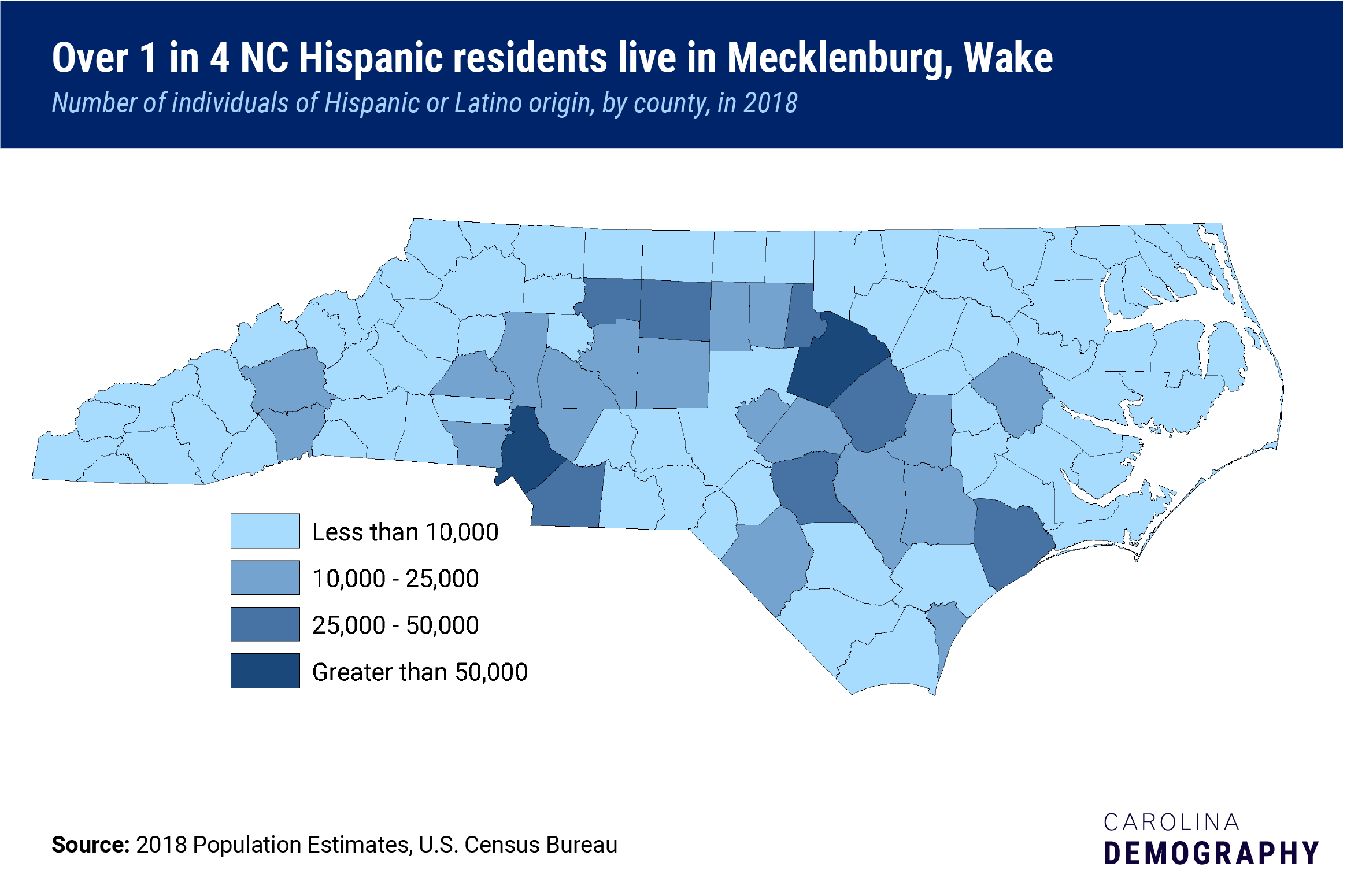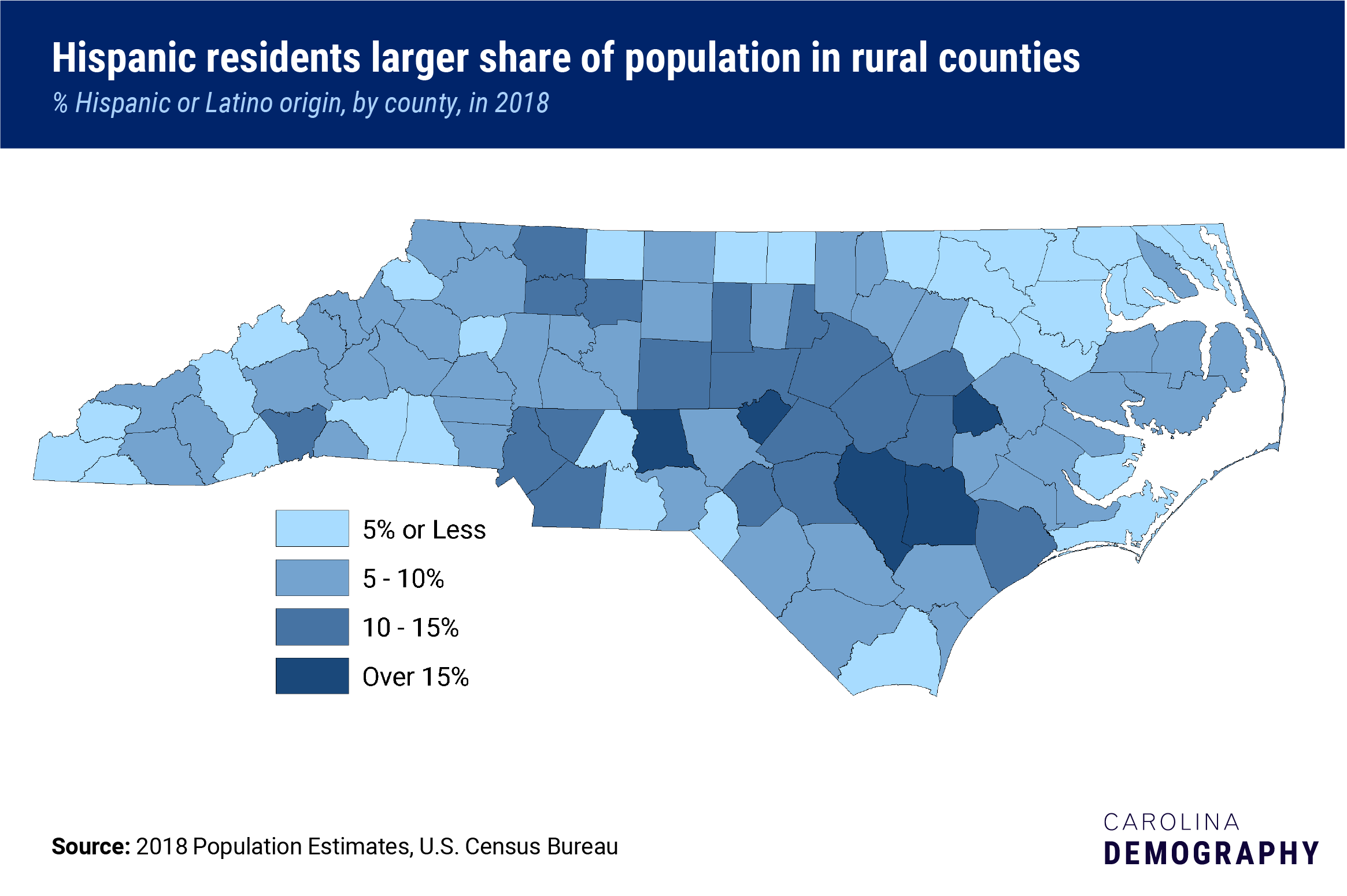North Carolina’s Hispanic Community: 2019 Snapshot

Terminology note: The U.S. Census Bureau introduced the term Hispanic in 1980 and this is a term preferred by some Hispanic/Latino populations. The term Latino became more commonly used in the 1990s and is preferred by others. Most recently, younger Latinas and Latinos have introduced the more gender-neutral term Latinx. In these posts and materials, we use the terms Hispanic and Latino interchangeably.
North Carolina’s Hispanic population is nearing 1 million, with 997,000 residents in 2018. The state’s Hispanic/Latino population grew from just over 75,000 in 1990 to 800,000 in 2010. Between 2010 and 2018, the U.S. Census Bureau estimates that North Carolina’s Hispanic population grew by 197,000 new residents, an increase of 24.6%, faster than the growth of this population nationwide (18.6%).

More than one in four NC Latino residents live in two counties: Mecklenburg (148K) or Wake (113K). The counties with the next largest Hispanic populations are Forsyth (49K), Guilford (43K), and Durham (43K) counties. In 23 North Carolina counties, there were fewer than 1,000 Hispanic residents in 2018.
Statewide, 9.6% of North Carolina’s population is Hispanic or Latino, roughly half the national average (18.3%). Though the Hispanic population is smaller in more rural counties, many of these counties have seen faster growth in this population over the past 28 years. As a result, Hispanic or Latino residents comprise a greater share of the population in many less populated, rural counties. In Duplin County, for example, 23% of residents are Hispanic; Sampson (20%), Lee (20%), Greene (16%), and Montgomery (15%) counties have similarly high proportions.

Nearly six of every ten Hispanics living in North Carolina are U.S.-born citizens (59%). Between 2000 and 2010, there were increases in both the U.S.-born and foreign-born Hispanic populations in North Carolina, though the U.S.-born population grew more quickly. 2010 marked the first year that more than half of the state’s Latino residents were born in the United States. Since 2010, the population of foreign-born Hispanic or Latino residents has not grown. Instead, the state’s Hispanic population has grown from births to current residents of North Carolina and from in-migration of U.S.-born Hispanic residents from other states.

Both U.S.- and foreign-born Latino populations represent a diversity of cultural/ethnic origins. Among the foreign-born population, Mexico is the leading country of origin: 237,000 individuals were born in Mexico, representing 60% of the state’s foreign-born Hispanic population. The Central American countries of El Salvador (32K), Honduras (30K), and Guatemala (18K) are the next most common countries of origin; 21% of foreign-born Hispanic/Latino North Carolinians are from one of these three countries.
Among all North Carolina Hispanic or Latino residents, including those born in the United States, 57% identify Mexican as their primary ancestry; 11% identify as Puerto Rican; and another 14% are of a Central American background like Salvadoran, Honduran, and Guatemalan.
For more details on North Carolina’s Hispanic population, download this one-page data snapshot.
Please note: Due to a data error, an earlier version of the one-page data snapshot contained incorrect data related to U.S. ancestry and broadband rates. This information has been corrected.
Need help understanding population change and its impacts on your community or business? Carolina Demography offers demographic research tailored to your needs.
Contact us today for a free initial consultation.
Contact UsCategories: NC in Focus
Tags: North Carolina

The Center for Women’s Health Research (CWHR) at the University of North Carolina School of Medicine released the 12th edition of our North Carolina Women’s Health Report Card on May 9, 2022. This document is a progress report on the…

Dr. Krista Perreira is a health economist who studies disparities in health, education, and economic well-being. In collaboration with the Urban Institute, she recently co-led a study funded by the Kate B. Reynolds Foundation to study barriers to access to…

Our material helped the NC Local News Lab Fund better understand and then prioritize their funding to better serve existing and future grant recipients in North Carolina. The North Carolina Local News Lab Fund was established in 2017 to strengthen…
Your support is critical to our mission of measuring, understanding, and predicting population change and its impact. Donate to Carolina Demography today.